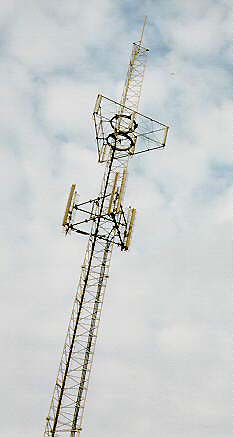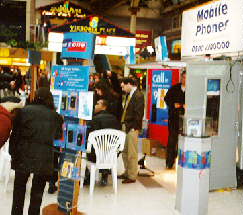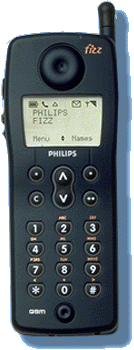GSM: Global System for Mobile Communications
In the 1980's an international working group tasked by most European PTT administrations
started to develop a common standard for cellular
networks. A joint standard allows international roaming across the many European
borders, until then only realized on a regional scale by the analog NMT-standard.
The main advantages of a
digital system are a larger user capacity per unit of spectrum, ease of implementation
of sophisticated encryption, authentication, and other security features, and
robustness against radio channel
imperfections. A Pan-European standard further provides economies of scale
in mass production of handheld and car terminals, which would never have been
achieved in the fragmented national markets in Europe. In the early 1980's, these
two objectives were seen as the most critical success factors for achieving a
much larger penetration of mobile telephone services in Europe. A third factor
has been the introduction of competition in the monopolistic European markets
- a cultural import from the US. In 1992, the new standard for Pan-European digital
cellular telephony, GSM, saw its first operational
successes.
Present Status
"The only truly unified European plug is wireless: The GSM antenna" :-)
| 1994 | In the autumn of 1994, 102 operators in 60 countries were committed to GSM. The networks already in operation had 3 million subscribers,
almost half of them in Germany. The commitment to GSM is formally expressed
by a Memorandum of Understanding (MoU). In Europe, this is arranged for by
the Commission of the European Communities (CEC), which took great pains to
ensure that common frequency allocations were made in the 900-MHz band in the
(then) 12 member states and in many other European countries.
|
| GSM MoU Members (October 1994)
|
| Region | Signatories | Countries
|
| Europe | 57 | 29
|
| Arab States | 10 | 10
|
| Asia Pacific | 29 | 17
|
| Africa | 6 | 4
|
| total | 102 | 60
|
|
Later, the GSM
standard was also adopted outside Europe, notably in important Asia-Pacific
countries such as Singapore, Malaysia, India, Hong Kong and Australia, and in
the Middle East and Africa. Taiwan, Thailand and New Zealand consider the GSM
standard, or have already imposed it for at least one of their competing
cellular networks. Accordingly, the old acronym GSM was taken to mean
Global System for Mobile Communication.
|
| Early 1997 |
In early 1997, GSM reached a penetration of 25% of the world market for mobile communications. 198 networks were operational in 75 countries. The number of subscribers exceeded 30 Million.
Tri-band handsets, capable of operating in the 900, 1800 and 1900 MHz band allow global roaming. The price of dual-band and tri-band handsets are 10 to 25 percent above the price of a single band set.
|
| End of 1997
| By the end of 1997, GSM had 60 Million subscribers in 110 countries,
giving GSM a 35% share of the world market in mobile telephony. The US GSM
system PCS 1900 had 670,000 subscribers.
|
| 1998
| The GSM Association announced that GSM attracted 135 Million subscribers
worldwide in 1998. This system had a share of 45% of the cellular market,
and 62% of the digital cellular market. Approximately 90 Million handsets
have been be sold, out of which 30 Million unit replace older technology,
or fashion-sensitive design. Ericsson, Nokia and Motorola dominate the market
with shares of 25, 24 and 20 percent, respectively, followed by Siemens,
Panasonic, Philips and Sony.
|
| 1999
|
In Finland and several other countries the number of cell phones exceeded
the number of wireline (POTS) subscribers. The GSM Short Message Service
(SMS) takes of. In Germany alone 2 million SMS messages are sent each
month. News and information services are started for instance by Nokia
and CNN. The WAP protocol for wireless web browsing is gaining lots of
attention.
Fierce compention between operators, particulary after many countries
have tird and fourth operators. US firm estimate that a mobile subscriber
represents a value of 2,000 to 12,000 USD.
Churn sales (replacement od existing phones) becomes a very significant
portions of all phone sales. New features are dual and tri-band phones,
and SMS. Good news for the phone manufacturors but, operators are worried
as they see subscribers move within one or or two years to a competitor.
|
Why a Pan-European standard?
The general advantages of international standards, MoU's and mutual roaming
agreements for public mobile telephony are increasingly appreciated by
different operators and markets. Where the inception and implementation of
such conventions lag behind, operators on their subscribers are denied some
of the following mutual benefits:
- interoperability with the national public
switched telephone network(s), including the Integrated Services Digital
network (ISDN);
- connectivity to all mobile users in an operator's
service area, stimulating cooperation between adjacent carriers;
- limiting
investments in inflexible cable infrastructure to the backbone network;
-
low cost of introducing service-area coverage, i.e., proportional to the
initial peak network use (erlang/unit area);
- simple upgrading of network
capacity, when and where economically justified, by reducing cell size ('cell
splitting');
- less economies of scale than in hardwired networks and, hence, less basis
for 'natural monopoly' arguments and for regulation against competition between
local network operators;
- ability to locate vehicles and roaming user
terminals, allowing automatic billing of users away from home their location
or own operator;
- international portability of a subscriber
identity module (SIM) smart card, authorizing personal and customized log-in
from compatible foreign terminals and competing networks by inserting the SIM
card.
Such benefits have caused the annual growth of mobile communications markets to
exceed 60% in many countries. No other telecommunications sector can boast similar
growth rates at present. The infrastructure supply market is dominated by the
few international manufacturers who combine expertise in both radio transmission
and national switching systems. One of these manufacturers, L.M. Ericsson of Sweden,
has some 40% of the cellular network market in the world, including a major proportion
of the older networks using the American analog standard AMPS.
The terminal market, on the other hand, is subject to the typical supply principles
and economics of consumer electronics: short product development times and a 'killing'
competition, due to eroding profit margins on microelectronics commodity products
in the late 1980's. The resulting drop in consumer prices assists in developing
the service market much faster than in the past. Several (US) operators even provide
a terminal for free as part of a subscription for a certain minimum period of
time.
 At January 1st, 1995, commercial GSM telephone service was already offered in
sixteen countries. The major transit routes in Europe had been reasonably
covered within one year after the first GSM service went on air in 1992,
despite initial delays in type approval of the first telephone handsets with
their complicated software. Some services are restricted to voice-type, i.e.,
circuit-switched, connections. A simple (packet-oriented) service allowing
transfer of short data or alphanumeric (i.e., paging-type) messages is also
becoming available. Moreover, a set of data rates have been defined as bearer
services in GSM and are supported at a later phase of the market
introduction of GSM.
At January 1st, 1995, commercial GSM telephone service was already offered in
sixteen countries. The major transit routes in Europe had been reasonably
covered within one year after the first GSM service went on air in 1992,
despite initial delays in type approval of the first telephone handsets with
their complicated software. Some services are restricted to voice-type, i.e.,
circuit-switched, connections. A simple (packet-oriented) service allowing
transfer of short data or alphanumeric (i.e., paging-type) messages is also
becoming available. Moreover, a set of data rates have been defined as bearer
services in GSM and are supported at a later phase of the market
introduction of GSM.
Strikingly, the fastest take-up of GSM has been in Germany, where the national
economy has been strained in the wake of the unification of East and West.
After only six months of operation in December 1992, Mannesmann Mobilfunk
announced the 100,000th subscriber to its GSM-network, known as D2. In May
1993, 220.000 users subscribed to D2. Mannesmann's competitor in Germany,
Deutsche Telekom, still holds the national monopoly on both public analog
mobile telephony and the fixed telephone network. Some 90% of all telephone
calls to or from mobile users in Germany originate or terminate in the latter,
and Telekom's analog cellular network, C1, is already virtually saturated by
its 800,000 subscribers. Nevertheless, Telekom's own GSM- network, D1,
initially attracted fewer subscribers than the competing D2 network. The
successful marketing of the D2 network services and the associated initial
offer of the 'Handy' portable GSM-terminal at a price of less than $ 1400
(including 15% tax, deductible for business users) was designed by D2's
American shareholder, AirTouch, a daughter company of Pacific Telesis.
Despite more advanced features consistent with the all-digital technology,
the lightweight 'Handy' could thus immediately be sold cheaper than a -
heavier - handheld terminal for the analog C1 network. The early explosion of
the GSM market in Germany caused a shortage of GSM terminals, especially
portables, in other European countries, resulting in initial waiting lists
and loss of network revenues.
 In 1997, the total number of subscribers reached 40 Million worldwide.
In May 1997, shortly after the introduction of PCS 1900, nine US operators
had 400,000 subscribers, with nearly 2000
new customers signing every day. Mid 1997, they covered
more than 300 cities with more than 20,000 inhabitants.
In 1997, the total number of subscribers reached 40 Million worldwide.
In May 1997, shortly after the introduction of PCS 1900, nine US operators
had 400,000 subscribers, with nearly 2000
new customers signing every day. Mid 1997, they covered
more than 300 cities with more than 20,000 inhabitants.
Competition
The German case illustrates the general trend towards increased mobile network
competition on the European continent, often spurred by more experienced
business partners from the less monopolistic Anglo-American shores of the
Atlantic Ocean. Clearly, the international GSM-standard and MoU, with strict
technical interface specifications and interworking requirements, paved the
way not only to international cooperation and roaming, but also to local
rivalry between competing cellular network operators. Introduction of network
competition was indeed one of the GSM policy objectives of the CEC in
Brussels. This regulatory change is the third key factor in the dynamics of
European mobile communications, next to the more technological driving forces
perceived by the founding fathers of GSM a decade ago, but it raises new
technical issues including tariffing, and service-related problems such as
portability of numbers between competing operators. At present, European
companies as Finnish Nokia, German Siemens and Ericsson of Sweden have the
lion's share of deliveries of GSM base stations and digital switching
equipment. The GSM switches can readily be interconnected with Intelligent-Network (IN) nodes, so that new competitive service offerings can be extended
into the fixed network. These include such features as storage of voice-mail
messages to or from mobile subscribers who have temporarily logged out of the
network, and call forwarding.
 While GSM was originally
intended and designed mainly as a vehicular system, it is now mostly marketed
as a system for handheld use. Thus, the market success of GSM success may
temper the initial growth of PCS in Europe, until the 900 MHz band becomes
locally saturated. In the US, the PCS standard based on GSM technology is
known as PCS-1900. It presently offers the most attractive prices for handsets
and network infrastructure, due to the world-wide takeup of GSM.
While GSM was originally
intended and designed mainly as a vehicular system, it is now mostly marketed
as a system for handheld use. Thus, the market success of GSM success may
temper the initial growth of PCS in Europe, until the 900 MHz band becomes
locally saturated. In the US, the PCS standard based on GSM technology is
known as PCS-1900. It presently offers the most attractive prices for handsets
and network infrastructure, due to the world-wide takeup of GSM.
The active presence of some of the most successful US Bell Operating Companies
(BOCs) in the consortia licensed by countries committed to the GSM-standard
can be taken as an American acknowledgment of the dominance of European
manufacturers in the rapidly growing market for digital mobile network
technologies. Conversely, the awards of such licenses in several countries of
the European Union can also be seen as a European acceptance of the greater
American service-provision experience and marketing skills. The remarkable
role of the BOCs abroad suggests that innovative technologies embedded in
common standards are not enough to develop a modern mobile service market.
This is confirmed by consideration of the evolution of another digital service
in Europe, mobile data communications.
History
- Started in 1982
- Initiated by CEPT (Conf. Europeenne des Postes et Telecommunications)
- 900 MHz band reserved in 1978
- 1986: decision to start implementation
- 1994 PTT Telecom opened 1 network in NL
- Access to ISDN related services
- DCS and GSM-R (GSM-Rail: TGV) evolved from GSM
- GSM+ more services, better efficiency
- Designed as vehicular; marketed as handheld
- Took lengthy ETSI standardization and Pan-European research: Most Voice Services
are now well defined, but some Data Services yet to be defined (uncertainty
to operators)
- Patent rights have been a problem
- Now also adopted in South Africa (rural fixed cellular), Singapore, Malaysia, India, Hong Kong, Australia, .... (South-East Asian MoU)
- May be successful also in US
(where IS54 TDMA and IS95 CDMA are competing). The FCC is auctioning spectrum, and winning operators may choose a GSM related system (PCS 1900).
Features and Services
- GSM offers pan-European roaming. Subscribers can call and can be called anywhere in Europe. This requires the network to provide for sophisticated
subscriber location and billing software.
- Digital encryption
- User authentication
- Smart (SIM) card: personal number
- Can support ISDN-type services
- Call redirect, automatic call-back
- Transparent G-3 fax mode
- Data Services to be standardized soon
- Nokia claims that stationary GSM channel is better than wireline modem
See also:




 At January 1st, 1995, commercial GSM telephone service was already offered in
sixteen countries. The major transit routes in Europe had been reasonably
covered within one year after the first GSM service went on air in 1992,
despite initial delays in type approval of the first telephone handsets with
their complicated software. Some services are restricted to voice-type, i.e.,
circuit-switched, connections. A simple (packet-oriented) service allowing
transfer of short data or alphanumeric (i.e., paging-type) messages is also
becoming available. Moreover, a set of data rates have been defined as bearer
services in GSM and are supported at a later phase of the market
introduction of GSM.
At January 1st, 1995, commercial GSM telephone service was already offered in
sixteen countries. The major transit routes in Europe had been reasonably
covered within one year after the first GSM service went on air in 1992,
despite initial delays in type approval of the first telephone handsets with
their complicated software. Some services are restricted to voice-type, i.e.,
circuit-switched, connections. A simple (packet-oriented) service allowing
transfer of short data or alphanumeric (i.e., paging-type) messages is also
becoming available. Moreover, a set of data rates have been defined as bearer
services in GSM and are supported at a later phase of the market
introduction of GSM.
 In 1997, the total number of subscribers reached 40 Million worldwide.
In May 1997, shortly after the introduction of PCS 1900, nine US operators
had 400,000 subscribers, with nearly 2000
new customers signing every day. Mid 1997, they covered
more than 300 cities with more than 20,000 inhabitants.
In 1997, the total number of subscribers reached 40 Million worldwide.
In May 1997, shortly after the introduction of PCS 1900, nine US operators
had 400,000 subscribers, with nearly 2000
new customers signing every day. Mid 1997, they covered
more than 300 cities with more than 20,000 inhabitants.
 While GSM was originally
intended and designed mainly as a vehicular system, it is now mostly marketed
as a system for handheld use. Thus, the market success of GSM success may
temper the initial growth of PCS in Europe, until the 900 MHz band becomes
locally saturated. In the US, the PCS standard based on GSM technology is
known as PCS-1900. It presently offers the most attractive prices for handsets
and network infrastructure, due to the world-wide takeup of GSM.
While GSM was originally
intended and designed mainly as a vehicular system, it is now mostly marketed
as a system for handheld use. Thus, the market success of GSM success may
temper the initial growth of PCS in Europe, until the 900 MHz band becomes
locally saturated. In the US, the PCS standard based on GSM technology is
known as PCS-1900. It presently offers the most attractive prices for handsets
and network infrastructure, due to the world-wide takeup of GSM.


